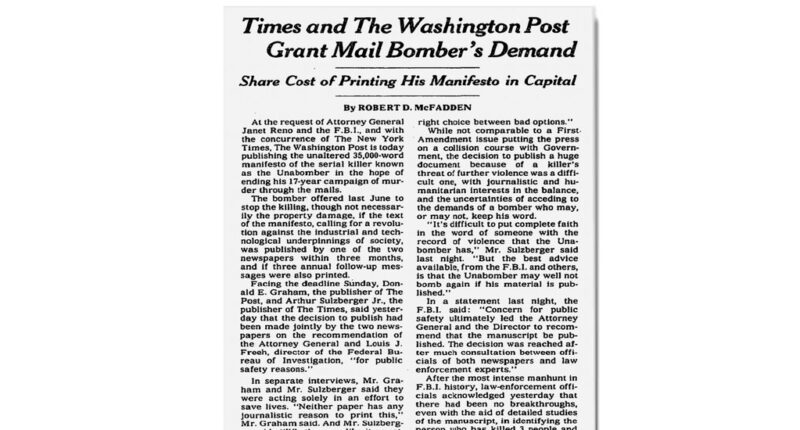
In June 1995, hefty packages arrived in the mail rooms of The Washington Post and The New York Times with identical contents: single-space typed copies of a document called “Industrial Society and Its Future,” with a note from an anonymous sender who said he would kill again unless the newspapers published the manifesto in its entirety within 90 days.
The danger seemed credible. The author claimed to have been responsible for three deaths and dozens of injuries in a mail bombing campaign that had already lasted 17 years, and was increasing in frequency. But if they gave in to the threat, how did the newspapers know the bomber would keep his word — or whether other terrorists would make such demands in the future?
In September of that year, at the urging of the Justice Department and the Federal Bureau of Investigation, the newspapers decided to publish. Because of its weekday printing capabilities, The Post ran the manifesto as an eight-page insert to distinguish it from the regular news and opinion sections; The Times covered half The Post’s costs.
The manifesto provided critical clues to his identity, and six months and two weeks later, the Unabomber — Theodore Kaczynski, who died in a federal prison cell on Saturday — was captured. But to many in the profession, acceding to Mr. Kaczynski’s demands set a terrible precedent, undermining journalistic independence and doing the bidding of law enforcement.
“They don’t know who this guy is, they can’t sue him for breach of contract if he bombs again,” said Jane Kirtley, then the executive director of the Reporters Committee for Freedom of the Press, in a round-table discussion soon after the manifesto’s publication. “They really made a pact with the devil when they have no control ultimately over what he will do or not do.”
The Newspaper Association of America found its membership evenly divided. In a poll at the time, exactly half of the 200 publishers who responded said they would have run the manifesto, while the other half disagreed.
The Times and The Post made clear it wasn’t an easy decision. They took nearly the whole 90 days allotted to think about it, and the choice wasn’t left to newsroom leaders. Instead, the newspapers’ two publishers issued a joint statement saying that they believed it could help save lives.
“Neither paper has any journalistic reason to print this,” said Donald E. Graham, then publisher of The Post. Arthur Sulzberger Jr., who was the publisher of The Times, agreed. “Whether you like it or not, we’re turning our pages over to a man who has murdered people,” he said. “But I’m convinced we’re making the right choice between bad options.”
After Mr. Kaczynski’s death on Saturday, Len Downie, who was the executive editor of The Post in 1995, told the newspaper that his boss was ultimately vindicated when Mr. Kaczynski’s brother recognized the phrasing and tipped off the F.B.I.
It wasn’t the first time and wouldn’t be the last that the media has grappled with the question of whether to serve as a platform for material that might inspire others to take harmful actions, or might mislead the public. The temptation to publish can be strong, especially when the documents could garner a lot of attention and have plausible news value.
BuzzFeed News reaped the traffic for publishing a dossier in 2017 that contained explosive allegations about President Donald J. Trump, for example, even though it was largely discredited years later. There is often intense interest in the manifestoes written by perpetrators of mass shootings, but news organizations now shy away from excerpting them, for fear of encouraging copycats.
“I think today we have more conversations about minimizing harm, and I think that’s a good thing,” said Kathleen Culver, director of the Center for Journalism Ethics at the University of Wisconsin-Madison.
Even in the 1990s, Dr. Culver said, the ferocious debate in journalism circles seemed academic to much of the public, when a killer was on the loose and the newspapers might have the power to stop him. “My principal memory from the time was people outside newsrooms saying, ‘Why was this a question?’”
At the same time, however, newspapers have faced criticism — and sometimes lost readers’ faith — for being too close to government authorities. Insufficiently critical reporting by The Times during the months leading up to the war in Iraq in the early 2000s is one example. A second is the media’s failure to adequately scrutinize statements by police departments in the wake of protests over the killing of an unarmed Black teenager in Ferguson, Mo.
John Watson, a journalism professor at American University’s School of Communication, said the newspapers should have allowed the Justice Department to buy an advertorial section for the manifesto, to satisfy Mr. Kaczynski’s demands while separating it from editorial decision making.
“Journalists should never be seen to be on the same side as the police,” Dr. Watson said. “Their ability to be watchdogs depends on the public believing that they will never be in bed with the government, they will always be skeptical, even if it is obvious that the government is right.”
Through a Times spokesperson, Mr. Sulzberger declined an interview, deferring to his comments at the time. His son, the current publisher of the Times, A.G. Sulzberger, recently published a long meditation on the meaning and value of journalistic independence. He did not respond to an email asking whether he would have made the same decision as his father.
Source: | This article originally belongs to Nytimes.com








